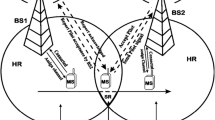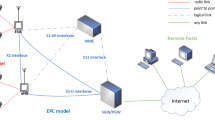Abstract
Packet buffering-and-forwarding is a simple mechanism and has been widely used to provide seamless handoffs in many wireless/mobile networks. However, some undesirable side effects of this mechanism, if not managed appropriately, can easily diminish its effectiveness in providing seamless inter-cell transitions during a handoff. We first examine these side effects and show how inappropriate buffer management by a mobility agent could affect the TCP performance. The throughput of TCP is then studied with special emphasis on the effects of a handoff. We then propose a Last-Come-First-Drop (LCFD) buffer management policy (to be employed by mobility agents) and post-handoff acknowledgement suppression (to be used by mobile nodes) to improvement the TCP performance. Our enhancements are backward compatible and suitable for the gradual/incremental deployment. By deriving an analytical model and conducting numerical analysis, we show that our scheme can improve the TCP throughput up to 30%. Finally, we conduct the ns-2-based simulation to confirm these numerical results, and demonstrate the applicability of the analytic model for predicting TCP throughput in other handoff schemes.
Similar content being viewed by others
References
A. Bakre and B. R. Badrinath, “I-TCP: Indirect TCP for mobile hosts,” in: Proc. International Conference on Distributed Computing Systems (1995) pp. 136–146.
H. Balakrishnan, S. Seshan and R. H. Katz, “Improving reliable transport and handoff performance in cellular wireless networks,” in: Wireless Networks, Vol. 1, No. 6 (1995) pp. 469–481.
S. Floyd, “TCP and Explicit Congestion Notification,” in: ACM Computer Communications Reviews, Vol. 24, No. 5 (1994) pp. 10–23.
M. Mathis, et al., “TCP selective acknowledge options,” in: RFC 2018 (1996).
N.H. Vaidya, M.N. Mehta, C.E. Perkins, and G. Montenegro, “Delayed duplicated acknowledgements: a TCP-unaware approach to improve performance Of TCP over wireless,” in: Wireless Communications and Mobile Computing, Vol. 2, No. 1 (2002) pp. 59–70.
Dongwook Lee and Jong Won Kim, “Delayed-duplicated ACK (DDA) algorithm for TCP performance enhancement to overcome packet sequence disruption in fast-handoff of Mobile IPv6,” in: 24th International Conference on Distributed Computing Systems Workshops 2004, pp. 98–103.
J. Kempf, et al., “Bidirectional Edge Tunnel Handoff for IPv6,” in: IETF Internet Draft (2001).
“Low latency handoff in mobile IPv4,” in: IETF Internet Draft (2001).
H.Yokota, A. Idoue, T. Hasegawa, and T. Kato, “Link layer assisted mobile IP fast handoff method over wireless LAN networks,” in: ACM Mobicom'02, pp. 131–139.
J.C. Wu, C.W. Cheng, N.F. Hunag, and G.K. Ma, “Intelligent handoff for mobile wireless Internet,” in: Mobile Networks and Applications, Vol. 6, No. 1 (2001) pp. 67–79.
C.E. Perkins and K.Y. Wang, “Optimized smooth handoffs in mobile IP,” in: IEEE ISCC'99, pp. 340–346.
R. Caceres and V. N. Padmanabhan, “Fast and scalable wireless handoffs in support of mobile Internet audio,” in: Mobile Networks and Applications, Vol. 3, No. 4 (1998) pp. 351–363.
Chun-Ting Chou and Kang G. Shin,“An Enhanced Inter-Access Point Protocol for Uniform Intra and Intersubnet Handoffs,” in: IEEE Transactions on Mobile Computing, Vol. 4, No. 4 (2005) pp. 321–334.
S. Ohzahata, S. Kimura and Y. Ebihara, “A proposal of seamless handoff method for cellular Internet environments,” in: IEICE Transactions on communications, Vol. E84-B, No. 4 (Apr. 2001) pp. 752–759.
M. Portoles and etc, ”IEEE 802.11 Link-Layer Forwarding For Smooth Handoff", in: PIMRC'03.
T. Goff, J. Moronski, D.S. Phatak and V. Gupta, “Freeze-TCP: A true end-to-end TCP enhancement mechanism for mobile environments,” in: IEEE Infocom'00, pp. 1537–1545.
C.F. Chan, H.K. Tsang and S. Gupta, “Impacts of handoff on TCP performance in mobile wireless computing", in: IEEE ICPWC'97, pp. 184–188.
C. Blondia, N. Wijngaert, G. Willems, and O. Casals, “Performance analysis of optimizid smooth handoff in MobileIP", in: ACM MSWIM'02, pp. 22–29.
G. Krishnamurthi, et al., “Buffer management for smooth handoffs in IPv6,” in: IETF Internet Draft (2001).
R. Caceres and L. Iftode, “Improving the performance of reliable transport protocols in mobile computing environments,” in: IEEE Journal on Selected Areas in Communications, Vol. 13, No. 5 (1995) pp. 850–857.
S. Floyd, “TCP and successive fast retransmits", in: URL:www. icir.org/floyd/papers/fastretrans.ps.
R. Ludwig and R. Katz, “The Eifel algorithm: Making TCP robust against spurious retransmissions,” in: ACM Computer communications Reviews, Vol. 30, No. 1 (Jan. 2000) pp. 30–36.
“Security Architecture for IP", in: RFC 2401 (1998).
W.R. Stevens, “TCP/IP Illustrated. Volume 2", Addison Wesley, MA (1994).
Author information
Authors and Affiliations
Corresponding author
Additional information
Chun-Ting Chou is currently a senior member research staff in Philips Research North America, Briarcliff Manor, New York. He received both the B.S. and M.S. degrees in Electrical Engineering from National Taiwan University in 1995 and 1997, respectively. He received the Ph.D. degree in Electrical Engineering and Computer Science from the University of Michigan, Ann Arbor, in 2004. He is actively involved in standardization of WiMedia Ultra-Wide Band (UWB) Wireless PANs, IEEE 802.15.3c high-speed wireless PANs and IEEE 802.15.5 meshed Wireless PANs. His current research interests include quality of service (QoS), MAC protocols for UWB Wireless PANs, 60-GHz wireless PANs using directional antennas, meshed wireless LANs and PANs, and spectrum agile and cooperative communication.
Kang G. Shin is the Kevin and Nancy O’Connor Professor of Computer Science and Founding Director of the Real-Time Computing Laboratory in the Department of Electrical Engineering and Computer Science, The University of Michigan, Ann Arbor, Michigan. His current research focuses on QoS-sensitive networking and computing as well as on embedded real-time OS, middleware and applications, all with emphasis on timeliness and dependability. He has supervised the completion of 54 PhD theses, and authored/coauthored around 630 technical papers and numerous book chapters in the areas of distributed real-time computing and control, computer networking, fault-tolerant computing, and intelligent manufacturing. He has co-authored (jointly with C. M. Krishna) a textbook “Real-Time Systems,” McGraw Hill, 1997.
He has received a number of best paper awards, including the IEEE Communications Society William R. Bennett Prize Paper Award in 2003, the Best Paper Award from the IWQoS’03 in 2003, and an Outstanding IEEE Transactions of Automatic Control Paper Award in 1987. He has also coauthored papers with his students which received the Best Student Paper Awards from the 1996 IEEE Real-Time Technology and Application Symposium, and the 2000 UNSENIX Technical Conference. He has also received several institutional awards, including the Research Excellence Award in 1989, Outstanding Achievement Award in 1999, Service Excellence Award in 2000, Distinguished Faculty Achievement Award in 2001, and Stephen Attwood Award in 2004 from The University of Michigan; a Distinguished Alumni Award of the College of Engineering, Seoul National University in 2002; and 2003 IEEE RTC Technical Achievement Award.
He received the B.S. degree in Electronics Engineering from Seoul National University, Seoul, Korea in 1970, and both the M.S. and Ph.D degrees in Electrical Engineering from Cornell University, Ithaca, New York in 1976 and 1978, respectively. From 1978 to 1982 he was on the faculty of Rensselaer Polytechnic Institute, Troy, New York. He has held visiting positions at the U.S. Airforce Flight Dynamics Laboratory, AT &T Bell Laboratories, Computer Science Division within the Department of Electrical Engineering and Computer Science at UC Berkeley, and International Computer Science Institute, Berkeley, CA, IBM T. J. Watson Research Center, Software Engineering Institute at Carnegie Mellon University, and HP Research Laboratories. He also chaired the Computer Science and Engineering Division, EECS Department, The University of Michigan for three years beginning January 1991.
He is Fellow of IEEE and ACM, and member of the Korean Academy of Engineering, is serving as the General Chair for the 3rd ACM/USENIX International Conference on Mobile Systems, Applications, and Services (MobiSys’05), was the General Chair of the 2000 IEEE Real-Time Technology and Applications Symposium, the Program Chair of the 1986 IEEE Real-Time Systems Symposium (RTSS), the General Chair of the 1987 RTSS, the Guest Editor of the 1987 August special issue of IEEE Transactions on Computers on Real-Time Systems, a Program Co-Chair for the 1992 International Conference on Parallel Processing, and served numerous technical program committees. He also chaired the IEEE Technical Committee on Real-Time Systems during 1991--93, was a Distinguished Visitor of the Computer Society of the IEEE, an Editor of IEEE Trans. on Parallel and Distributed Computing, and an Area Editor ofInternational Journal of Time-Critical Computing Systems,Computer Networks, and ACM Transactions on Embedded Systems.
Rights and permissions
About this article
Cite this article
Chou, CT., Shin, K.G. Smooth handoff with enhanced packet buffering-and-forwarding in wireless/mobile networks. Wireless Netw 13, 285–297 (2007). https://doi.org/10.1007/s11276-006-7525-y
Published:
Issue Date:
DOI: https://doi.org/10.1007/s11276-006-7525-y




